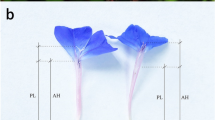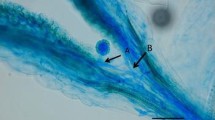Summary
A factorial cross design was used to evaluate the influence of differences among pollen donors and recipients on variation in stylar attrition of pollen tubes in self-fertile plants of Petunia hybrida. Pollinations to flower buds were used to reduce the inhibitory ability of the style and these crosses were compared with flower pollinations to assess the degree of stylar influence on pollen fertilization ability. There was less pollen tube attrition after bud pollinations than after flower pollinations, indicating that styles of buds were less able to inhibit pollen tubes. The variance component for plants acting as pollen donors tended to be greater after flower pollinations than after bud pollinations. The lower variance in male success after bud pollinations indicates that differences among pollen donors after flower pollinations were due to stylar inhibition of pollen rather than differences in pollen vigor. Since the level of variation in pollen growth after pollination to flowers was greater among clones than among ramets within clones, the differences in pollen fertilization ability are probably genetically based.
Similar content being viewed by others
References
Anderson MA, Cornish EC, Mau SL, Williams EG, Hoggart R, Atkinson A, Bonig I, Grego B, Simpson R, Roche PJ, Haley JD, Penschow JD, Niall HD, Tregear GW, Coghlan JP, Crawford RJ, Clarke AE (1986) Cloning of cDNA for a stylar glycoprotein associated with expression of self-incompatibility in Ni-cotiana alata. Nature 321:38–44
Ascher PD (1984) Self-incompatibility. In: Sink KC (ed) Petunia. Springer, Berlin Heidelberg New York, pp 92–110
Barrett SCH (1988) The evolution, maintenance, and loss of selfincompatibility systems. In: Lovett Doust JL, Lovett Doust L (eds) Plant reproductive ecology. Oxford University Press, New York, pp 98–124
Bateman AJ (1948) Intra-sexual selection in Drosophila. Heredity 2:349–368
Charlesworth D, Schemske DW, Sork VL (1987) The evolution of plant reproductive characters; sexual versus natural selection. In: Stearns SC (ed) The evolution of sex and its consequences. Birkhauser, Basle, pp 317–335
Cruzan MB (1989) Pollen tube attrition in Erythronium grandiflorum. Am J Bot 76:562–570
Ewart L (1984) Plant breeding. In: Sink KC (ed) Petunia. Springer, Berlin Heidelberg New York, pp 180–202
Lande R (1981) Models of speciation by sexual selection of polygenie traits. Proc Natl Acad Sci USA 78:3721–3725
Lyons EE, Waser NM, Price MV, Antonovics J, Motten AF (1989) Sources of variation in plant reproductive success and implications for concepts of sexual selection. Am Nat 134:409–433
Mather K (1943) Specific differences in Petunia. I. Incompatibility. J Genetics 45:215–235
Marshall DL, Folsom MW (1991) Mate choice in plants: an anatomical and population perspective. Annu Rev Ecol Syst 22:37–63
Nettancourt D de (1977) Incompatibility in angiosperms. Springer, New York Berlin Heidelberg
Olmstead RG (1989) The origin and function of self-incompatibility in flowering plants. Sex Plant Reprod 2:1–10
SAS Institute (1985) SAS user's guide: statistics. SAS Institute, Cary, N.C.
Sayers ER, Murphy RP (1966) Seed set in alfalfa as related to pollen tube growth, fertilization frequency, and post-fertilization ovule abortion. Crop Sci 6:365–368
Shivanna KR, Rangaswamy NS (1969) Overcoming self-incompatibility in Petunia axillaris. I. Delayed pollination, pollination with stored pollen, and bud pollination. Phytomorphology 19:372–380
Stephenson AG, Bertin RI (1983) Male competition, female choice, and sexual selection in plants. In: Real L (ed) Pollination biology. Academic Press, New York, pp 110–149
Takahashi H (1973) Genetical and physiological analysis of pseudo-self-compatibility in Petunia hybrida. Jpn J Genet 46:27–33
Uyenoyama MK (1988) On the evolution of genetic incompatibility systems: incompatibility as a mechanism for the regulation of outcrossing distance. In: Michod RE, Levin BR (eds) The evolution of sex. Sinauer Associates, Sunderland, pp 212–232
Waser NM, Price MV, Montalvo AM, Gray RN (1987) Female mate choice in a perennial herbaceous wildflower, Delphinium nelsonii. Evol Trends in Plants 1:29–33
Willson MF, Burley N (1983) Mate choice in plants: tactics, mechanisms, and consequences. Princeton University Press, Princeton
Wright S (1965) The distribution of self-incompatibility alleles in populations. Evolution 18:609–619
Yokoyama S, Hetherington LE (1982) The expected number of self-incompatibility alleles in finite plant populations. Heredity 48:299–303
Author information
Authors and Affiliations
Rights and permissions
About this article
Cite this article
Cruzan, M.B. Analysis of pollen-style interactions in Petunia hybrida; the determination of variance in male reproductive success. Sexual Plant Reprod 6, 275–281 (1993). https://doi.org/10.1007/BF00231905
Issue Date:
DOI: https://doi.org/10.1007/BF00231905




